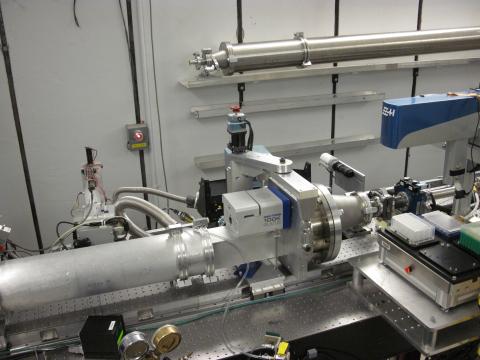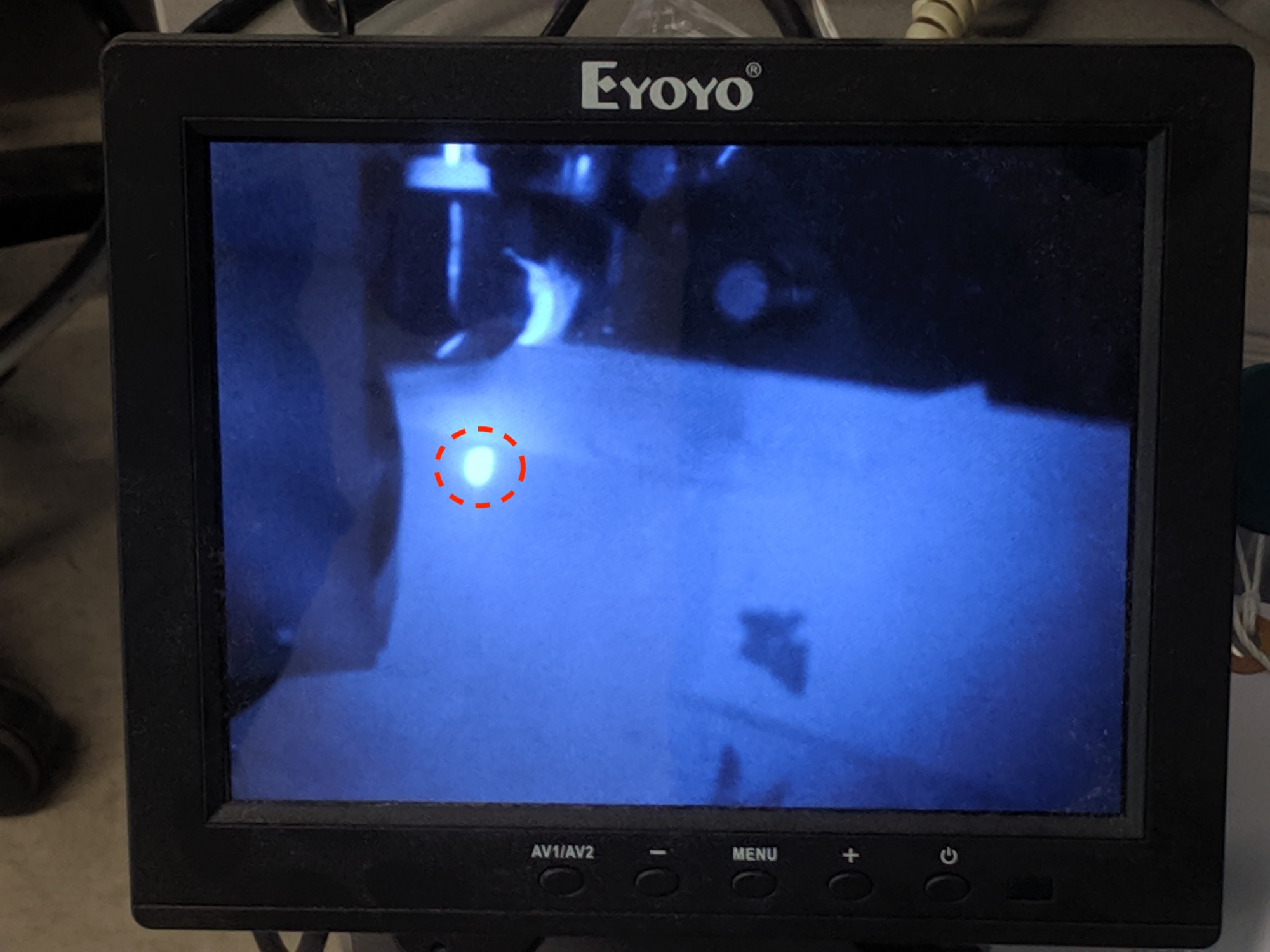Beamline characteristics (prior to 2019)
Publications using data collected at BioSAXS require an acknowledgement of funding sources. In addition, beamline characteristics for the corresponding run(s) must be reported and included in data depositions.

CHESS-U Commissioning Run: May-July 2019

Commissioning Period (positron ring current 49 ma max)
beam diameter 250 um x 250 um (beam-defining slit)
6/30/19 E = 9.835 keV (1.260 A) Flux = 2.8x10^12 ph/s standard SAXS tests
7/7/19 E = 13.880 keV (0.8933 A) Flux = 4.5x10^11 ph/s HP-SEC-SAXS tests
7/13/19 E = 13.880 keV (0.8933 A) Flux = 2.1x10^11 ph/s HP-SAXS tests
Run Info: January - May, 2018
G1 Station:
E = 9.924 keV (1.249 Å) 1/31/18
E = 11.296 keV (1.0976 Å) 5/20/18
beam diameter 250 µm x 250 µm
Flux = 7.7x1011 ph/s (1/31/18)
Flux = 4.56x1011 ph/s (4/20/18)
Flux = 5.59x1011 ph/s (4/25/18)
Run Info: October - November, 2017
G1 Station:
E = 9.9099 keV (1.2511 Å)
beam diameter 250 µm x 250 µm
Flux = 7.73x1011 ph/s (11/02/17)
Flux = 7.56x1011 ph/s (11/08/17)
Flux = 7.19x1011 ph/s (11/24/17)
Run Info: May - June, 2017
G1 Station:
E = 9.8833 keV (1.254489 Å), end of the run, 7/23
beam diameter (250 µm x 250 µm)
Flux = 5.9 x 1011 photons/s (5/21/17)
Flux = 5.7 x 1011 photons/s (5/31/17)
Run Info: January - February, 2017
G1 Station:
E = 9.846 keV (1.259 Å)
beam diameter (250 µm x 250 µm)
Flux = 1.24 x 1012 photons/s (start of run)
Flux = 1.08 x 1012 photons/s (2/8)
Note: transient intensity drops by as much as 60% were observed roughly every 12 hr throughout this run. This problem was eventually located in the upstream beamline optics (a heat transfer issue) and resolved, but only at the end of the BioSAXS run. Since the change was very slow, it did n ot affect sample normalization and would be noticeable only as weaker-than-expected signals lasting few hours twice a day. You can check to see if you were affected by comparing the I1 counter values at various times located in the image header files. At start of run, I1 = 375000 counts/s.
Run Info: October - November, 2016
G1 Station:
E = 9.8528 keV (1.2584 Å)
beam diameter (250 µm x 250 µm)
November 11:
Flux = 8.4 x 1011 photons/s
November 4:
Flux = (am) 7.5 x 1011 photons/s
(re-optimized to 1.2 x 1012 photons/s based on beamstop reading)
October 29:
Flux = 1.1 x 1012 photons/s
October 26:
Flux = 6.5 x 1011 photons/s
Standards concentration
Lysozyme - 4.21 mg/ml ± 0.03 mg/ml
Glucose Isomerase - 0.33 mg/ml ± 0.004mg/ml
November 9:
Lysozyme - 4.00 mg/ml ± 0.01 mg/ml
Run Info: May - June, 2016
G1 Station:
Beam diameter 250 µm x 250 µm
May 21:
E = 9.781 keV (1.267 Å)
Flux = 7.76 x 1011 photons/s @ 124 ma
June 1:
E = 9.781 keV (1.267 Å)
Flux = 9.0 x 1011 photons/s @ 105 ma
Standards concentration
Lysozyme - 4.44 mg/ml ± 0.01 mg/ml
Glucose Isomerase - 0.44 mg/ml ± 0.004 mg/ml
Run Info: February - April, 2016
G1 Station:
Beam diameter 250 µm x 250 µm
Note: some SEC runs may have used 250 micron (V) by 500 micron (H) beam with approx 8 x 1011 photons/s flux)
March 16:
E = 9.822 keV (1.262 Å)
Flux = 4.35 x 1011 photons/s @ 100 ma
March 30:
E = 9.822 keV (1.262 Å)
Flux = 4.42 x 1011 photons/s @ 99 ma
April 1:
E = 9.822 keV (1.262 Å)
Flux = 3.26 x 1011 photons/s @ 99 ma
Standards concentration
Lysozyme - 4.12 mg/ml ± 0.03 mg/ml
Glucose Isomerase - 0.45 mg/ml ± 0.01mg/ml
Run Info: November - December, 2015
G1 Station:
E = 9.962 keV (1.245 Å)
Beam diameter 250 µm x 250 µm
Flux (photons/s) = 8.4 x 1011 @ 92.5 ma on 11/6
- 7.3 x 1011 @ 92 ma 11/11
- 3.6 x 1011 @ 92 ma 11/14
- 5.9 x 1011 @ 92 ma on 11/18
- 9.9 x 1011 @ 92 ma on 11/25 (500 µm x 250 µm)
- 5.6 x 1011 @ 91.4 ma on 12/2
Note: we experienced flux variations from day to day during this run.
Beamstop counter readings (“diode”) in the image headers can be used to estimate actual flux. Conversion factor is 5.56 x 1011 photons/s per 222991 counts/s on beamstop diode.
Minimum sample volumes:
using the robot 25 µL
manual loading 20 µL
recommended working volume 30 µL
Detector: dual Pilatus 100K-S SAXS/WAXS
q-space range:
qmin = 0.0075 - 0.28 Å-1
qmax = 0.22 - 0.8 Å-1
Recommended sample exposure: 10 frames @ 2 s each (20 s)
Standards concentration
Lysozyme - 4.27 mg/ml ± 0.01 mg/ml
Glucose Isomerase - 0.47 mg/ml ± 0.01mg/ml
Run Info: February 4 - 24, 2015
G1 Station:
E = 9.963 keV (1.244 Å)
Beam diameter 250 µm x 250 µm
Flux = 3.63 x 1011 photons/s @ 51 ma
Minimum sample volumes:
using the robot 25 µL
manual loading 20 µL
recommended working volume 30 µL
Detector: dual Pilatus 100K-S SAXS/WAXS
q-space range:
qmin = 0.007 Å-1
qmax = 0.7 Å-1
Recommended sample exposure: 10 frames @ 2 s each (20 s)
Standards concentration
Lysozyme - 4.14 mg/ml ± 0.02 mg/ml
Glucose Isomerase - 0.577 mg/ml ± 0.01mg/ml
Run Info: October 8 - December 9, 2014
G1 Station: primary station for BioSAXS experiments
Note: this was a transitional period in the synchrotron upgrade plan that required running with a temporary 30 cm undulator at variable and lower than normal positron currents.
Energy = 11.75 keV (1.055 Å)
Beam diameter 250 µm x 500 µm
Detector: dual Pilatus 100K-S SAXS/WAXS
q-space range:
qmin = 0.007 Å-1
qmax = 0.7 Å-1
F1 Station: only used during BioSAXS workshops
Energy = 12.686 keV (0.97733 Å)
Detector = Dectris Pilatus 100k S (SAXS only)
Sample-to-detector distance = 1140 mm
Beam diameter = 250 µm x 250 µm
Flux = 1.5 x 1011 photons/s
Minimum sample volumes:
using the robot 25 µL
manual loading 20 µL
recommended working volume 30 µL
q_space range: 0.0164 to 0.45 Å-1
(using improved SAXS.cfg mask created after class end)
Standards concentration
Lysozyme - 4.33 mg/ml ± 0.02
Glucose Isomerase - 0.625 mg/ml ± 0.01
Past runs info
G1 Station:
E = 9.968 keV (1.257 Å) (as of 10/18/2013)
Beam diameter 250 µm x 250 µm
Flux = 1.6 x 1011 photons/s (as of 10/18/2013)
Minimum sample volumes:
using the robot 25 µL
manual loading 20 µL
recommended working volume 30 µL
Detector: dual Pilatus 100K-S SAXS/WAXS
q-space range:
qmin = 0.007 Å-1
qmax = 0.7 Å-1
Recommended sample exposure: 10 frames @ 2 s each (20 s total).
F2 Station:
E = 9.881 keV (decommissioned 6/13/2013)
Beam diameter: 250 µm × 250 µm
Flux = 2 x 1010 photons/s
Minimum sample volumes:
using the robot: 15 µL
manual loading: 5 µL (practical limit)
recommended working volume: 30 µL
Detector: dual Pilatus 100K-S SAXS/WAXS
q-space range:
qmin = 0.008 Å-1
qmax = 0.8 Å-1
Total exposure times: 300-600 s
Typical throughput: 80 sample plugs per 24 hours (about 20 protein samples including buffer, dilutions, and cleaning).